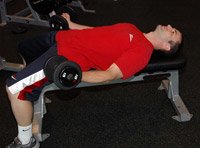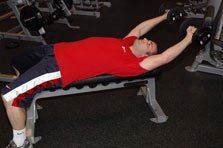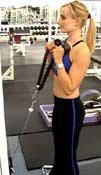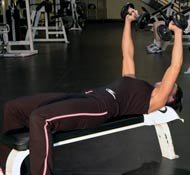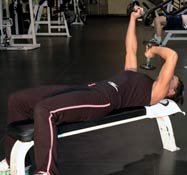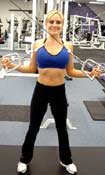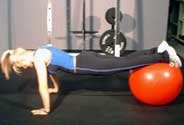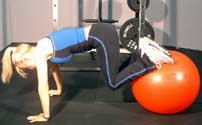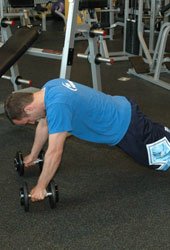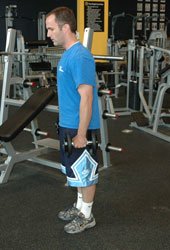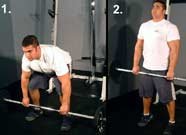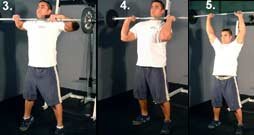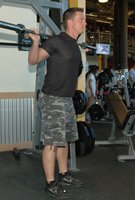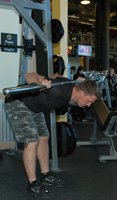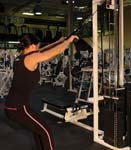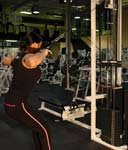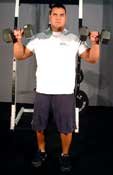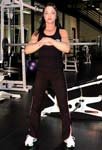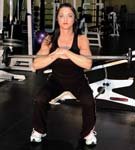The Question
There are an uncountable number of exercises; however, there are the same few exercises that everyone uses in their workouts.
What are the best unheard-of/underused exercises? (Include a description of how they are performed)
Why are these exercises so unheard-of and underused?
How do these exercises compare to the more "mainstream" exercises?
Bonus Question: How often do you incorporate these exercises into your workout routine?
Show off your knowledge to the world!
The Winners:
- TwinIam View Profile
- soundcheck129 View Profile
- 1st place 75 in store credit.
- 2nd place 50 in store credit.
1st Place: TwinIam
View This Author's BodySpace Here.
There are an uncountable number of exercises; however, there are the same few exercises that everyone uses in their workouts.
For convenience, I shall categorize the exercises by the body part that is being worked by the movement in question. Although some of these exercises will certainly be new to you, please forgive the inclusion of any maneuvers that seem common to you. I accept no credit for the creation of the following movements the majority of them come from magazines, websites, or my fellow trainees.
Chest
Around The Worlds:
Motion: The following description comes from the Bodybuilding.com Exercise Database:
"Grab two dumbbells and sit on a bench. Now put the dumbbells face up towards the ceiling on your upper thighs while keeping your elbows slightly bent. Now move the barbells, not up, but around as if you are drawing an angel in the snow. Bring them behind your head so that they touch each other and return to the original position."
I love this movement because of the continuous tension experienced by all areas of the pecs at the top of the range of motion the upper chest is involved, at the bottom it's the lower chest, etc. This movement produces a great pump and burn in the chest, but unfortunately it puts a strain on the shoulders, so use caution.
Reps/Sets: Don't overuse this exercise to avoid unnecessary shoulder wear and tear keep your rep/set range to 8-10 reps for 3-4 sets.
Weight: You should be able to complete this motion with a weight slightly less than a weight you can do flyes for 10 reps.
Standing One-Arm Dumbbell Flyes:
Motion: Stand upright with your right side about six inches from a vertical pole and your left hand holding a dumbbell at your side. Take hold of the pole with your right hand and lean to your left until your right arm is straight.
Holding the weight at a 45-degree angle to your body, bring it in a diagonal, upward line to the right (keeping both arms only slightly bent or perfectly straight). Flex your pecs at the peak before lowering the weight to starting position. Repeat with the other side.
Reps/Sets: This movement is a great workout finisher because of the pump potential. Aim for 4-6 sets of 12+ reps.
Weight: Choose a light weight for this exercise you're going for pump more than strength with this maneuver.
Back
Typewriters:
Motion: The "typewriter" movement is an offspring of the pull up created for rock-climbers. On a pull-up bar, take a shoulder-width overhand grip and pull yourself up until your chin is above the bar. Immediately "shift" to the right so that your left arm is extended and your right hand is near your right ear. Hold this position for a couple seconds and then "shift" to your left side and repeat until your chin drops below the bar.
Reps/Sets: Go to failure (chin below the bar) for 5+ sets.
Weight: Kudos to you if you can pump out a good number of reps with your bodyweight, but due to the difficulty of this exercise, don't be ashamed to use a exercise band until your strength and endurance builds.
Uneven Pull-Ups:
Motion: Grasp a pull-up bar with your right hand in an overhand grip. Loop a towel around the other side of the bar so that the end hangs about a foot from the bar and grab onto it (close to the top at first) with your left hand. Proceed to use both hands to pull your body up until your chin is over the bar. Repeat for reps and switch sides.
This movement is great for targeting each lat individually.
Reps/Sets: Go to failure for 3-5 sets.
Weight: Bodyweight is sufficient for this exercise (if you can't pull your self up then work on your normal pull-up strength first). As you become stronger with this movement, lower the hand holding the towel inch by inch until you're at the end of the towel.
After you become strong enough to rep your bodyweight with your hand at the end of the towel, you should be able to perform a one-handed pull-up!
Cross-Body Cable Row:
Motion: Stand with your left side about a foot from a low pulley with a D-handle attached. Bend at the waist about 45 degrees and slightly bend your knees. Cross your right arm across your body, grasp the handle, and pull the handle across your body by squeezing your right shoulder blade towards the left. Slowly return the weight to its starting place.
Concentrate on squeezing your lats throughout the entire movement. Repeat for the other side.
Reps/Sets: This exercise is a great finishing pump exercise, so aim for about 4 sets of 12-15 reps.
Weight: Don't use too much weight; just enough to get blood flowing to your back. Individual weights will vary greatly.
Biceps
Behind-The-Back Smith Machine Drag Curl:
Motion: Stand with your back to a smith machine bar that is racked about knee height. Grab the bar with your palms facing towards you, and "drag" the bar up your back by squeezing your biceps and letting your elbows push backwards. Your range of motion isn't huge for this exercise the bar should stop just above your butt. Flex your biceps at the top and lower the bar slowly.
Reps/Sets: This exercise is another amazing pump movement. I've done sets of up to 50 reps with this exercise, but 3 sets of 12-15 reps would be fine.
Weight: About 70% of the weight you curl for 10 reps.
Rope Hammer Curl:
Motion: The following description comes from the Bodybuilding.com Exercise Database:
"Attach a rope attachment to a low pulley. Stand face forwards and about 12 inches away from the machine. Grasp the rope with a palms-in grip and stand straight up. Put your elbows at your side and KEEP them there during the entire movement. Your elbows should not move. Pull your arms up until your biceps touch your forearms, keeping your palms in a facing in position. Slowly return to the starting position and repeat."
Reps/Sets: This exercise lends itself to lower reps; about 4 sets of 6-8 reps is ideal.
Weight: Try to lift about 10 pounds more than you normally hammer curl for 10 reps (if you add the weights of each dumbbell together).
One-Arm Barbell Curl:
This movement is great because of all the extra stabilizer muscles that are required in its execution compared to a dumbbell curl.
Motion: Grasp a barbell in one hand with a palm-up grip. Proceed to squeeze your bicep to bring the barbell up to shoulder level (without letting your elbows flare outwards) and then slowly let the bar down.
Reps/Sets: This movement is awesome for strength and/or size, so try for 3-5 sets of 6-10 reps.
Weight: The barbell itself might be hard for some of you. Try for about 80% of what you normally curl for your desired rep range (you'll be surprised by this move's difficulty).
Triceps
Lying Triceps Extension Across Face:
Motion: Hold 2 dumbbells above your chest while lying on a flat bench, like you are at the top of a dumbbell chest press. Position your arms at approximately 30-degree angles to your body. Bend your arm at the elbow until the dumbbells are about an inch off your chest, then explode them upward to the starting position, flexing your triceps at the top.
Reps /Sets: You won't feel your muscles working for the first few reps the extreme burn comes at the end of your set. The constricted nature of this movement restricts blood flow to the triceps, facilitating lactic acid production. As such, you'll be hard pressed to complete more than 12 reps. Aim for 8-12 reps for 3 sets.
Weight: The same weight that you use for your one-arm standing triceps extensions should work well for this movement.
Behind-The-Back Press-Down:
Motion: Stand with your back facing a lat pull-down station (or a high pulley station with a wide bar attachment). Pull the bar to shoulder height and grab it with your hands spaced about shoulder width apart (both palms-in and palms-out grips work). Press the bar down to just below your butt, flex your triceps intensely, and then slowly return to the top of the movement. Don't let your shoulders move nor your elbows flare outwards for the duration of the movement.
Reps/Sets: This exercise is awesome for both strength and size; shoot for 3-5 sets of 6-10 reps.
Weight: You can go extremely heavy with this weight (after all, it is similar to parallel bar dips). Try to press a little less than your bodyweight.
Shoulders
Lying Row:
Motion: Lie on your back on a seated row station with a long straight-bar attachment. Both wide and narrow grips work for this movement. Grasp the bar palms-down and pull it to your chin. Hold it at peak contraction while flexing your delts, and then lower it slowly in control.
Reps/Sets: Standard; 8-12 reps for 3-4 sets.
Weight: Since this movement isolates the deltoid muscles more than its cousin, the upright row, try for about 80% of what you lift on that exercise.
High/Low Cable X:
Motion: Stand facing a double pulley station, about 6 inches back from the line of the pulleys. Grasp the end of each pulley (high or low) and cross them either up or down so that they form the letter "X" in front of your face.
Make sure that your arms are straight throughout the movement and end in line with your body. Slowly let the cables return to their starting positions. I find it best if I do this exercise without handles, but D handles will work fine.
Reps/Sets: You can get a great rear delt pump with high reps for a few sets; go for 3 or 4 sets, 12+ repetitions each.
Weight: You should be able to use a slightly greater weight than you would normally use for bent-over lateral raises.
Legs
One-Legged Squat:
While the Smith Machine version of this movement is practiced often, the free weight version is seen less frequently. The free weight version requires much more balance and recruits a virtual army of stabilizer muscles.
Motion: Stand on one leg and slowly bend at the waist and knee until you reach a deep squat position. It's alright if you can't make it all the way down to "glutes on hams" just focus on going as low as you can comfortably go.
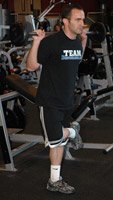
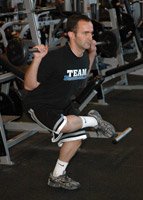
 Click To Enlarge.
Click To Enlarge.
One-Legged Squat.
Video : Windows Media
Reps/Sets: Stick to low reps for this very difficult movement: 5-8 reps for 4 or 5 sets.
Weight: The balance required for the execution of this exercise may have some people struggling to squat just their bodyweight. That's fine, but the bar adds a whole new level of difficulty. Don't expect to even near your normal squat weight for this move.
"Jump" Leg Presses:
A variation of the jump squat, just harder and at a different angle. A good power exercise.
Motion: Perform a basic leg press, but explode to the top with more force so that the platform leaves your feet. Don't lock out at the top, as that could hurt your knees. Also, DON'T KEEP YOUR LEGS STRAIGHT WHEN YOU CATCH THE WEIGHT! Buckle your legs and absorb the weight, or the shock of the weight hitting you could cause some serious problems.
Reps/Sets: Since this exercise should be performed for its power-increasing benefits, crank out 5 or more sets of 3-5 explosive reps.
Weight: It depends on how far you want the platform to soar from your feet, but about a third of your normal leg press weight for 10 reps should be okay.
Abs
Exercise Ball Roll-Ins:
Motion Start in push-up position with your knees on an exercise ball. Clench your lower abs to roll your shins up the ball while simultaneously pushing your butt up into the air. Roll your shins back, careful not to bounce for momentum at any time during the movement.
Reps/Sets: High reps for this one: 3 sets of 15+.
Weight: Unless you want to go for a lower rep range (in which case you would need a weight vest), bodyweight should be fine.
Weighted Reverse Crunch:
Motion: Lie on your back, feet on the floor, knees up, with your feet attached in some way to a low-pulley (I use a neck attachment and loop my feet through, but whatever you can find that gets the job done will do fine). Keeping the bend in your knees at about 90 degrees, pull your legs as far up as you can. Lower the weight without letting it touch the weight stack and repeat.
Reps/Sets: 8-12 reps for 3-5 sets.
Weight: There really isn't a valid reference point for the weight on this exercise. Just experiment and see what works for you.
Why Are These Exercises So Unheard-Of And Underused?
These exercises remain obscure for three primary reasons: either they are awkward to perform (one-legged squat), they are embarrassing to execute (exercise ball roll-ins, which require you to stick your butt up in the air), or they are just plain hard (typewriters).
The use of mainstream exercises is perpetuated by trainees who refuse to research new ways of training, new ways to progress towards their goals. Unfortunately, the search for variety in one's training is the key to growth. Bodybuilding isn't a comfort sport; people need to expand their horizons and use new exercises to breach their comfort zone.
How Do These Exercises Compare To The More "Mainstream" Exercises?
Some of the aforementioned exercises are merely refining maneuvers, but others are advanced techniques that are comparable to (or better than) the mainstream exercises from which they are derived. For example, cross-body cable rows merely expand on the traditional row by hitting the muscle fibers in a different way.
On the other hand, one-legged squats are significantly harder than regular squats and require a much greater level of skill and recruitment of stabilizing muscle fibers.
Don't switch out all your foundational exercises for these new variations and don't overuse them either unchanging routines stunt growth. Rather, aim to switch up your workouts every once in a while with these movements rather than rely on them every training session.
How Often Do You Incorporate These Exercises Into Your Workout Routine?
I don't use these exercises any more frequently than I utilize more common exercises. I switch up my routine every workout, trying to not favor any exercises over others. The exercises that I enjoy the most out of those listed above would have to be the behind-the-back drag curl and exercise ball roll-in I use the latter to target my stubborn lower abs frequently.
2nd Place: soundcheck129
View This Author's BodySpace Here.
There are an uncountable number of exercises, however, there are the same few exercises that everyone uses in their workouts.
Go to any gym in the world, and you'll probably see a very similar scene a lot of bench pressing, a lot of curls, a lot of back squats. Despite the countless different movements the body is capable of making, most fitness enthusiasts tend to repeat the same ones, adhering to a body of "preferred" lifts.
For some reason, some lifters seem to be afraid of thinking outside the box and using unique or less common exercises. In fact, you may even get some odd looks or comments if you start doing a relatively unknown lift. Unfortunately, sticking to the same lifts limits the effectiveness of your workouts. Different movements can challenge your muscles and battle your body's tendency to adapt.
What Are The Best Unheard-Of/Underused Exercises?
There are so many great exercises that most lifters sadly may never use. While some are merely variations of existing lifts, some are quite unique.
Rack Chins:
Place an unweighted bar (one you would usually use for deadlifts) horizontally onto a squat rack at about chest level. Next, find an adjustable bench and set the chair back so it is on an incline. Place a dumbbell or plate on your stomach, and hang from the bar with your feet atop the chair and pull yourself up with your arms.
This is a great exercise for your shoulders, biceps and back, particularly your lats. The line of pull is one not easily accessed by other lifts, and the barbell/plate allows you to adjust resistance easily; you don't have to just rely on body weight, and you can track progress easily. This is one of my favorites, rarely do I have a workout that does not include this move.
The Gunthar Row:
Lie on back extension bench, with dumbbells in each hand. Lower body to starting position for a back extension, and slowly lower torso up until back is straight. While maintaining this position, perform a rowing motion with each arm. This can also be performed with a barbell.
This is basically a combination of a back extension and a row, but I think this is greater than the sum of its parts. You'll be working your back extra hard with the added weight, and you'll have to keep your back stabilized while your performing the rows. It's a unique challenge because you're probably not used to performing rows without your feet on the ground.
Burpees:
Start by squatting down with hands on floor. Next, kick feet back and lower your self into a push-up. While pushing up, bring your feet back under you and then leap as high as possible. Repeat.
This move is a staple of Ross Enamait's routines, most of which are aimed towards fighters. While similar to push ups and squats, this adds an explosive element, which most traditional gym moves do not have.
It works your lower and upper body simultaneously while testing your endurance and cardiovascular fitness. If you could only perform one exercise on a given day, I'd recommend this one.
Clean And Press:
Squat down with bar in front of you, feet shoulder-width apart. In a fluid motion, extend knees to bring bar up and pull with arms, shrugging shoulders at top. Rotate elbows under bar to "catch" it, and then push it above your head.
Like the Burpee, this lift involves an explosive movement. It also works practically every muscle group shoulders, triceps, biceps, back, legs and abdominals.
It is relatively easy to perform once you get used to it, but it can be exhausting. However, that means you know you're getting a lot out of it it should be a staple if efficiency is your goal. For an added challenge, I like to perform an overhead squat after the "press" portion.
Cable Pull-over:
Lie on a decline bench, with head on end near cable attachment. Reach back and grasp rope attachment to begin, then pull over chest while keeping arms as straight as possible. Extend as far as you can, keeping abs tight throughout. Bring back slowly.
This is another lift that challenges your muscles by attacking a line of pull that is seldom touched by other exercises. The unique angle is a great change from traditional shoulder lifts and also provides a massive range of motion. The Pullover is a highly effective compound movement.
Good Morning:
Place a barbell behind your shoulders while standing upright. Keep your back straight and bend at the waist slowly, stopping when your torso is parallel to the floor. Return to starting position slowly.
It seems that the preference of body part splits sometimes leaves the back somewhat neglected. The Good Morning changes that, working your entire posterior chain, from your back down to your legs.
While concentrating on keeping my back straight, I like to squeeze my abdominals you'd be surprised how much you can feel this in your core, too. This strengthens your lower back, which is a bigger part of overall strength than people realize.
YTWLI:
Lie face down on an incline bench, arms hanging at sides with thumbs pointing up. From this position, bring arms up to form the following letters, five times each, with your body: Y (hands at 10 and 2 o'clock positions), T (hands straight out to sides), W (bend elbows 90 degrees and raise arms), L (elbows bent, raise arms with forearms pointing straight up), I (press hands overhead).
A word of warning: this will fry your shoulders. This is a great warm-up even unweighted, and is absolutely deadly with weights. Be prepared to use much lighter weights than you're used to, as this is a challenge of your strength and muscular endurance.
It's extremely effective, though, because it moves you through every conceivable plane of motion. Once your traps are burning, you'll hate this, but when you realize how much it does for your body, you'll love it.
Face Pulls:
Stand with arms extended in front of high cable attachment. Grasp rope in each hand and pull it toward your face, squeezing shoulder blades together and keeping elbows high.
This is an odd-looking but effective exercise for your arms, back and shoulders. It can be used in place of traditional rows. You can feel it in your delts and your upper back; be careful to pull too quickly or you'll feel it in your face as well.
Reverse Curls:
Stand gripping dumbbells or barbell with palms facing down. Press elbows firmly to side and lift until arms are fully flexed.
You may be thinking that these are basically just regular curls, so why bother using them? Why not? The reverse curl is every bit as effective, and actually targets your forearm more than traditional curls. This is key because forearms are often neglected and can make a big difference in overall strength and grip.
Dumbbell Handstand Push-ups:
Set up a few inches away from a wall with your hands on dumbbells. Kick up into a handstand position against the wall. Carefully lower yourself toward the floor, and then back up again.
You may get some curious looks while performing this, but it will pay off in strength gains. This provides a challenge for your upper back and shoulders, and the usage of the dumbbells allows you to reach a fuller range of motion than traditional handstand push-ups. In addition, it keeps your wrists in a more comfortable, and less injury-prone, position.
Zercher Squats:
Set a weighted bar on the floor and deadlift it to your lower quads. Balance the bar on your quads and slide your arms under it up until the elbow. When it is secure, stand up. Reverse the move and then repeat.
To be honest, this isn't the most comfortable exercise. But a little pain goes a long way, as the Zecher does wonders for your back and hamstring.
It demands a lot from your body, just like a regular squat or deadlift, but the way the bar is gripped is a more accurate reputation of how you'd carry a large object outside of the gym. Having an impressive bench is one thing, but having strength in real-life situations is pretty important too.
Why Are These Exercises So Unheard-Of And Underused?
Considering how effective these exercises are, it's somewhat mystifying as to why they aren't used more frequently. However, one reason that may explain it is peer-pressure. When a beginner walks into the gym for the first time, he's more likely to imitate what others are doing than to try something new.
The popularity of more 'traditional' lifts such as squats, curls and bench presses has created a mindset that if you aren't using these exercises, you're doing something wrong. As a result, people focus on the popular lifts and don't look for alternatives. And if curls and presses are working, people are reluctant to try something different.
The underused exercises suffer from a vicious cycle of unpopularity. Because they are rarely used, these lifts rarely get attention from magazines, websites, and movies, so people don't ever see them in use. Thus, they become more and more obscure.
A lot of times when I'll do one of these exercises, people look at me as if I'm an alien; that's not treatment that really encourages you to continue what you're doing.
Another reason for under use is that some of these lifts require more time or space to set up and perform. Burpees, for example, require a lot of space, and most weight rooms don't have large open areas.
The dumbbell handstand push-ups require open wall space, which can be hard to come by. As for Zercher squats, some may consider the initial steps just a waste of time when they could be doing traditional squats. Rack chins also require you to use both a squat rack and a bench, which can be asking a lot at smaller gyms where there is not a lot of equipment to go around.
Perhaps most significantly, a lot of these lifts are difficult. New and different exercises that demand a lot of muscular coordination are not conducive to 'ego lifting,' a plague that convinces some lifters that the more weight you push, the better it is, regardless of how much you're actually using your muscles.
When I first tried the YTWLI, for example, it was a very humbling experience. No one wants to be the guy struggling with 5lb dumbbells. Cable Pullovers can be very challenging as well, and it's embarrassing if you have to stop a set at three reps because you're not used to working certain muscles all at the same time.
Lastly, some lifters tend to focus on working only muscles they can flex, and tend to miss the big picture of overall strength. Having a beach body is nice, but if you don't have the complete strength to back it up, it seems a bit pointless to me. Your back, shoulders and legs may not be the areas that eyes tend to gravitate toward, but they are vital parts of stabilization and overall strength in functional movements and sports.
How Do These Exercises Compare To The More "Mainstream" Exercises?
While they are not as popular as the mainstream exercises, these relatively unknown lifts are every bit effective, if not more. For example, Burpees are far more effective than regular push-ups, as they combine that motion with a jump-squat and a significant cardio element.
The Clean and Press improves explosive strength, which is important for sports, and also works a large number of muscles simultaneously. Increasing the range of motion is a nice advantage to the Cable Pullover and the Dumbbell Handstand Push-ups. Meanwhile, Good Mornings can challenge your core while they work your hamstrings something that simple leg curls aren't going to do.
With that said, the more mainstream exercises are great too, or else they probably wouldn't be so widely used. However, the exercises listed above shouldn't be underestimated just because they aren't as popular.
How Often Do You Incorporate These Exercises Into Your Workout Routine?
I'm a big proponent of these apparently forgotten exercises, so I make sure to incorporate a few into every workout. I still recognize the effectiveness of the mainstream exercises, but I love the extra challenge that things like YTWLI provide. It's also cool to see others catch on to an interesting lift and watch as it spreads around the gym.
I like to incorporate a lot of different lifts because I think the body progresses best with variety. I always do Rack Chins instead of seated rows because I like the unique angle. Also, a lot of days I'm pressed for time, so the Clean and Press is a great way to work my shoulders, legs, back and arms all at once, instead of isolating each group.
Burpees are another great time saver I'm not a fan of cardio, but I need to do it to stay in shape for sports, so I'll pound out a few sets and work up a sweat that would have taken hours on the bike.
There's no need to remove all of the mainstream exercises from your routine, but recognizing that there are effective alternatives is a good idea because it keeps things fresh.



